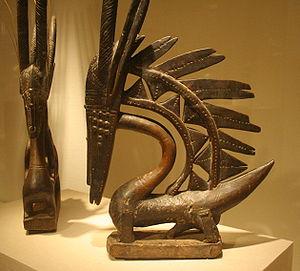
African sculpture
Encyclopedia

Regional variations
Sculptures are created and symbolized to reflect the region that they are made in. The materials and techniques used to create the sculptures and the function of the sculptures are very different from region to region.In West Africa
West Africa
West Africa or Western Africa is the westernmost region of the African continent. Geopolitically, the UN definition of Western Africa includes the following 16 countries and an area of approximately 5 million square km:-Flags of West Africa:...
the figures have elongated bodies, angular shapes, and facial features that represent an ideal rather than an individual. These figures are used in religious rituals and the surface is often coated with materials placed on them in ceremonial offerings. In contrast to these sculptures are the ones of Mande
Mande
Mande may refer to:* Mandé peoples of western Africa* Mande languages* Manding, a term covering a subgroup of Mande peoples, and sometimes used for one of them, Mandinka* Garo people of northeastern India and northern Bangladesh...
-speaking peoples of West Africa. Their sculptures are made of wood and have broad, flat surfaces while the arms and legs are shaped like cylinders.
In Central Africa
Central Africa
Central Africa is a core region of the African continent which includes Burundi, the Central African Republic, Chad, the Democratic Republic of the Congo, and Rwanda....
the key characteristics include a heart shaped faces that curve inward and patterns of circles and dots. Although some groups prefer more of a geometric and angular face and form. The materials used range from mostly wood
Wood
Wood is a hard, fibrous tissue found in many trees. It has been used for hundreds of thousands of years for both fuel and as a construction material. It is an organic material, a natural composite of cellulose fibers embedded in a matrix of lignin which resists compression...
all the way to ivory
Ivory
Ivory is a term for dentine, which constitutes the bulk of the teeth and tusks of animals, when used as a material for art or manufacturing. Ivory has been important since ancient times for making a range of items, from ivory carvings to false teeth, fans, dominoes, joint tubes, piano keys and...
, bone
Bone
Bones are rigid organs that constitute part of the endoskeleton of vertebrates. They support, and protect the various organs of the body, produce red and white blood cells and store minerals. Bone tissue is a type of dense connective tissue...
, stone
Rock (geology)
In geology, rock or stone is a naturally occurring solid aggregate of minerals and/or mineraloids.The Earth's outer solid layer, the lithosphere, is made of rock. In general rocks are of three types, namely, igneous, sedimentary, and metamorphic...
, clay
Clay
Clay is a general term including many combinations of one or more clay minerals with traces of metal oxides and organic matter. Geologic clay deposits are mostly composed of phyllosilicate minerals containing variable amounts of water trapped in the mineral structure.- Formation :Clay minerals...
and metal
Metal
A metal , is an element, compound, or alloy that is a good conductor of both electricity and heat. Metals are usually malleable and shiny, that is they reflect most of incident light...
. Overall though the Central African region has very striking styles that it is very easy to identify which area the sculpture was produced in.
Eastern Africa is not known for their sculptures but one type that is done in this area is pole sculptures. These are a pole carved in a human shape and decorated with geometric forms, while the tops are carved with figures of animals, people and various objects. These poles are then placed next to graves and are associated with death.
Southern Africa
Southern Africa
Southern Africa is the southernmost region of the African continent, variably defined by geography or geopolitics. Within the region are numerous territories, including the Republic of South Africa ; nowadays, the simpler term South Africa is generally reserved for the country in English.-UN...
’s oldest known clay
Clay
Clay is a general term including many combinations of one or more clay minerals with traces of metal oxides and organic matter. Geologic clay deposits are mostly composed of phyllosilicate minerals containing variable amounts of water trapped in the mineral structure.- Formation :Clay minerals...
figures date from 400 to 600 A.D. and have cylindrical heads. These clay figures have a mixture of human and animal features. Other than clay figures there are also wooden headrests that were buried with their owners. The headrests had styles ranging from geometric shapes to animal figures.

